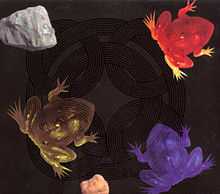Frog (album)
From Wikipedia, the free encyclopedia
| Frog | ||||
|---|---|---|---|---|
 | ||||
| Studio album by Merzbow | ||||
| Released | October 2001 | |||
| Recorded | February 2001–2002 at Bedroom, Tokyo | |||
| Genre | Noise | |||
| Length |
33:58 (LP) 92:26 (CD) | |||
| Label | Misanthropic Agenda | |||
| Producer | Masami Akita | |||
| Merzbow chronology | ||||
| ||||
| Professional ratings | |
|---|---|
| Review scores | |
| Source | Rating |
| Allmusic | |
Frog is an album by the Japanese noise musician Merzbow.[2] It was inspired by frogs and utilizes their sounds. Masami Akita exhibited the audio and images at Yokohama Triennale 2001 in an installation called "Moss Garden" (苔庭 kokeniwa).[3][4] It was reissued on CD in 2002, retitled Frog+, with a bonus disc of additional material and a screensaver.
Merzbow continued the frog theme on A Taste Of..., Puroland and Houjoue.
The album was used as source material for the remix album Frog Remixed and Revisited.
Track listing
All music composed by Masami Akita.| CD 1 | ||||||||||
|---|---|---|---|---|---|---|---|---|---|---|
| No. | Title | Length | ||||||||
| 1. | "Suzumebachi No Rinbu" | 9:15 | ||||||||
| 2. | "Hikigaeru Ga Kuru" | 6:28 | ||||||||
| 3. | "Denki No Numa" | 7:42 | ||||||||
| 4. | "Kaeru No Shima" | 6:18 | ||||||||
| 5. | "Catch 22" | 4:14 | ||||||||
Total length: |
33:58 | |||||||||
| CD 2 | ||||||||||
|---|---|---|---|---|---|---|---|---|---|---|
| No. | Title | Length | ||||||||
| 1. | "Black Frog" | 18:04 | ||||||||
| 2. | "Track777" | 16:01 | ||||||||
| 3. | "Track555" | 9:04 | ||||||||
| 4. | "Frog Variation No.2" | 15:20 | ||||||||
Total length: |
58:31 | |||||||||
Personnel
- Masami Akita – performer, photos, collage art
- Jenny Kawabata – design, support
Release history
| Region | Date | Label | Format | Quantity | Catalog | Sold Out |
|---|---|---|---|---|---|---|
| United States | 2001 | Misanthropic Agenda | LP | 1000 | MAR 003 | Yes |
| 2002 | CD | MAR 004 | No |
References
- ↑ Frog at AllMusic. Retrieved July 21, 2012.
- ↑ "Merzbow - Frog+ (CD)". Discogs. Retrieved June 17, 2012.
- ↑ "Merzbow/Fennesz/Antenna Farm". Friend of the Devil. Retrieved June 17, 2012.
- ↑ "Artist data sheet". The Japan Foundation. 2001. Retrieved June 17, 2012.
This article is issued from Wikipedia. The text is available under the Creative Commons Attribution/Share Alike; additional terms may apply for the media files.